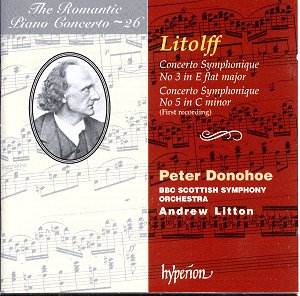Henry LITOLFF (1818-1891)
Concerto Symphonique No 3 in E-flat Major, National Hollandais Op.45 (c.1846)
Concerto Symphonique No 5 in C Minor, Op.123 (1870)
Peter Donohoe (piano); BBC Scottish Symphony Orchestra/Andrew Litton
Rec. October 2000
HYPERION CDA67210 [65.55]
Crotchet AmazonUK AmazonUS Amazon recommendations
Henri Litolff was one of the great composer-pianists of the 19th Century who was initially taught music by his musician father, a small-time violinist. At fourteen Henri's talent was noticed by Moscheles who declared him so good he took him as a pupil. Later, when a proficient pianist, Litolff undertook concert tours on the continent (Leipzig, Prague and Berlin in particular). His five concertos were the focus of his professional career and indicate his likely technical abilities as a pianist. Their construction links the classically orientated style of the early 19th Century with the rich orchestration and rhythmic invention characterised by the late 19th Century. Litolff's style shares with Berlioz a ring of eccentricity in his harmonic progressions using structural designs which have an unpredictability and power to surprise. Berlioz monitored his progress and referred to Litolff "as one of our best composers", praising his knowledge, inspiration, mobility of melodic style, and excellence of orchestration.
Litolff broke new ground by modelling his concerti on the structure of the symphony where four movements are used in place of the traditional three, and in which the Scherzo provides a significant part of the work.
He wrote his Concerto Symphonique No 3 around 1846 when he was in Holland. It was written to express his gratitude to the Dutch people for granting freedom after escaping from a British custodial sentence. (When divorcing his English wife he had been ordered to pay an impossible £2000 for which he was thrown in debtor's prison. He escaped and went to Holland, hence the gratitude.) In the work he uses two old Dutch tunes. In certain places one could be forgiven for thinking one is listening to Beethoven (his Third concerto in particular) yet there is a freshness in the sprightly composition which gives the impression of youthful energy.
An Allegro provides a powerful opening of military style, and introduces all the thematic material. A second exposition expands the material already heard in the orchestral introduction. Then a spirited coda restates the military theme as a grand closing gesture.
In the Scherzo a hunting scene comes to mind with its 'tripping' figures. The soloist and orchestra provide a dialogue with an orchestrally dominated theme of a Dutch children's song.
A peaceful Andante in a simple ternary song form features the cello and horn. This conveys a nocturnal, lyrical mood of relaxing charm, (reminiscent of Field) with the piano syncopating a flowing horn melody.
An Allegro vivace provides the closing movement which with a certain degree of lightness moves with some urgency to finally break into a trumpet-led rendering of the Dutch National song "Wein Neerlands bloed". (This song was widely sung in Belgium in 1830 during an uprising against the House of Orange.) The song weaves in and out of the movement before virtuosity brings the piece to an energetic close.
Of 30 minutes duration the work is taken little slowly but in no way does the performance drag. The scintillating interpretation by Donohoe is captivating, particularly in the fourth movement where extreme agility is shown in his fingerwork during rapid passages of semiquavers and double octaves.
The maturely composed Concerto Symphonique No 5 was always well respected, but has enjoyed less attention than the other concerti. The scale of the work is larger and more dramatic; the orchestral colour more spacious and harmonic colour more experimental. This is the first recording of the work. In performance, it poses a technical challenge in all movements yet Donohoe rises to the occasion admirably.
An Allegro maestoso opens the work. The structure is similar to that of the earlier concertos but the expression of ideas is different and a stylistic change towards romanticism is evident. There is a broader contour to the melody lines and greater strength in the counter-melodies.
A Largo follows with a haunting melody provided by horn and cello, more of a 'song without words'. The piano provides a Lisztian response to the opening orchestral statement.
The Scherzo vivace provides a contrast with the previous movement with angular sevenths and sudden tonal shifts tempered by colourful scoring and rhythmic vitality.
To close, the Allegro is described as one of Litolff's most bizarre and eccentric creations yet it retains the composer's clear signature. His recapitulatory process is highly imaginative: in place of the conventional restatement of the first subject he inserts an extended cadenza of ferocious technical difficulty. Besides transforming the first subject, the cadenza (a full-blown fugue) functions as a secondary development within the wider context of the movement's sonata structure.
This is a charming recording with a strong soloist and played with typically superb BBC SSO polish. Hyperion as usual rises to the occasion and provides a generous 12 pages of notes for each language (English/French/German) which not only detail Litolff's life and give interesting information on the concerti, but additionally adds good musical detail about the compositions and parallels comparison with other composers. The recording quality is excellent with orchestral sections not masked by the piano but in tk. 1 (9:10 in for 30s) and again in tk. 8 (3.06 in) a regularly measured thud possibly from a piano pedal is lightly distracting.
Raymond WalkerAlso released by Hyperion-
CDA66889 Litolff: Concertos Symphoniques Nos 2 and 4, again with Peter Donohoe under Andrew Litton and the Bournemouth Symphony Orchestra
